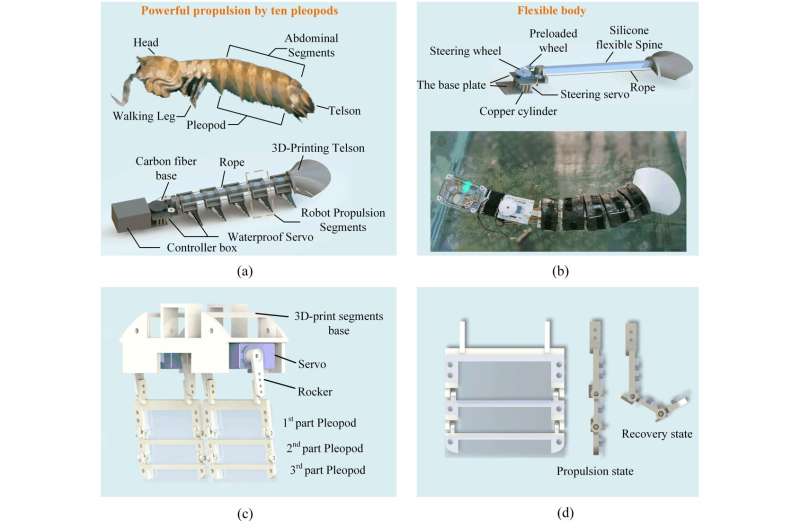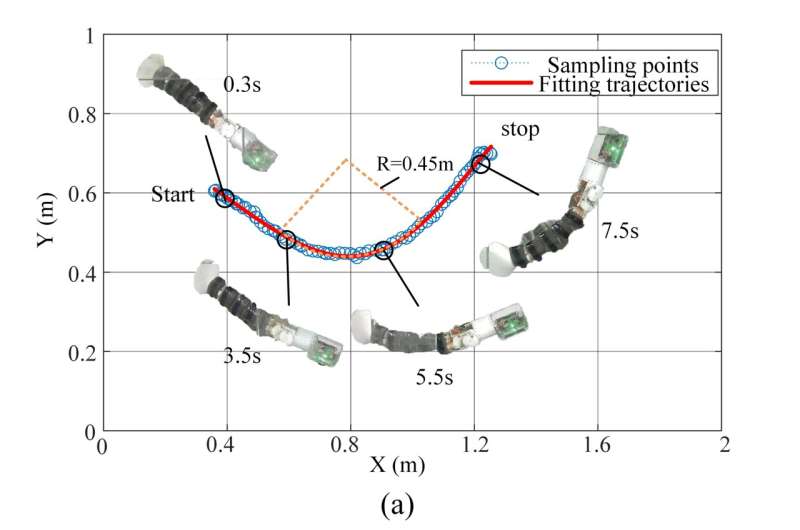November 13, 2023 feature
This article has been reviewed according to Science X's editorial process and policies. Editors have highlighted the following attributes while ensuring the content's credibility:
fact-checked
trusted source
proofread
A robot inspired by mantis shrimp to explore narrow underwater environments

Nature is the primary source of inspiration for many existing robotic systems, designed to replicate the appearance and behavior of various living organisms. By artificially reproducing biological processes, these robots can help tackle complex real-world problems more effectively.
Researchers at Zhejiang Sci-Tech University and University of Essex developed a robot inspired by mantis shrimp that could help to explore and monitor narrow underwater environments that are inhabited by numerous animal species and rich in mineral resources. This bio-inspired robot was presented in a paper published in IEEE/ASME Transactions on Mechatronics.
"Many underwater environments have narrow spaces that are difficult to access for humans, thus it would be optimal for robots to take over their exploration," Gang Chen, one of the authors of the paper told Tech Xplore. "Mantis shrimp is a flexible and fast swimming small predator in the marine environment, and its excellent motion ability can provide new research ideas for the development of underwater robots. This work takes mantis shrimp as the bionic object, designs a new mantis shrimp robot, and completes its motion control."
Inspired by the abilities and movements of mantis shrimp, Chen and his colleagues set out to artificially replicate them. Their hope was to develop an underwater robot that could move remarkably well underwater, imitating the mechanisms that support the movements of mantis shrimp and thus also easily accessing narrow spaces underwater.
The agile robot created by the researchers, consisting of 10 artificial pleopods and a flexible body, has strong propulsion capabilities. Pleopods are the fork-shaped limbs attached to the body of crustaceans, which allow the animals to move around in water.
"The bionic mantis shrimp robot is driven by five pairs of pleopods," Chen explained. "A balance of velocity and stability can be achieved by adjusting the movement frequency, amplitude, and phase difference of the motion of these five pairs of pleopods. In addition, the connection of each pair of pleopods is independent, which is very useful for repairing in case of structural damage underwater."
The movements of the team's robot are controlled through the bending of its flexible torso using a wire, along with the movement of its artificial pleopods. Collectively, these mechanisms allow the robot to rapidly adjust the angle at which it is turning, so that it can swim in the desired direction.

"The multiple pleopods are redundant, which can enable the robot to realize turning even when some of the pleopods fail," Chen said. "The bionic pleopod is designed with three joints, one of which is an active joint driven by servomotor and the remaining two joints are passive joints, which use the resistance of water to achieve unfolding and folding."
Essentially, when one of the robot's limbs moves backwards, its three joints fully expand, leading to maximum propulsion. In contrast, when the limb returns to its original position, the joints fold, reducing forward resistance. This unique design leverages the characteristics associated with the flowing of water to simplify the robot's structure, increase its propulsion capacity and make it easier to control underwater.
"The overall structure of the bionic mantis shrimp robot refers to the biological mantis shrimp structure and the robot body is flat with a streamlined telson to effectively reduce drag," Chen said. "The pleopod and body of the robot adopt rigid-flexible coupling design to reduce the impact of water on the robot and improve the stability of the robot in underwater motion."
The researchers tested a prototype of their mantis shrimp robot and found that it could move well underwater, reaching a maximum velocity of 0.28 m/s and a minimum turning radius of 0.36 m. These results highlight the potential of the robot for tackling exploration missions in narrow and complex underwater environments.
Notably, both the velocity and movements of the mantis shrimp robot can be precisely and easily controlled, reducing the risk of collisions with underwater obstacles. The researchers now plan to develop their system further, with the hope that it will eventually be used to monitor and rescue marine environments.
"In the future, we will focus on how to realize autonomous movement of the bionic mantis shrimp robot in a narrow underwater environment to complete the detection task in this environment," Chen said.
"We plan to optimize the structure, shape, and hardware system design of the robot to improve its six-degree-of-freedom motion ability in 3D space and higher underwater motion speed. Then, the IMU, camera, depth sensor, and other information acquisition devices will be increased to achieve more accurate closed-loop motion control of the robot through the analysis of environmental information and the feedback adjustment of its own posture."
While the team's robot already achieved encouraging results, it is still at an early stage of development. Chen and his colleagues will now continue to improve and test their robot, to ascertain its ability to navigate cramped underwater environments.
"In our next studies, we will also enhance the durability and reliability of each of the robot's components, using carbon fiber and embedded high-strength materials," Chen added. "This could lay the foundation for practical applications in confined underwater environments."
More information: Gang Chen et al, Design and Control of a Novel Bionic Mantis Shrimp Robot, IEEE/ASME Transactions on Mechatronics (2023). DOI: 10.1109/TMECH.2023.3266778
© 2023 Science X Network


















